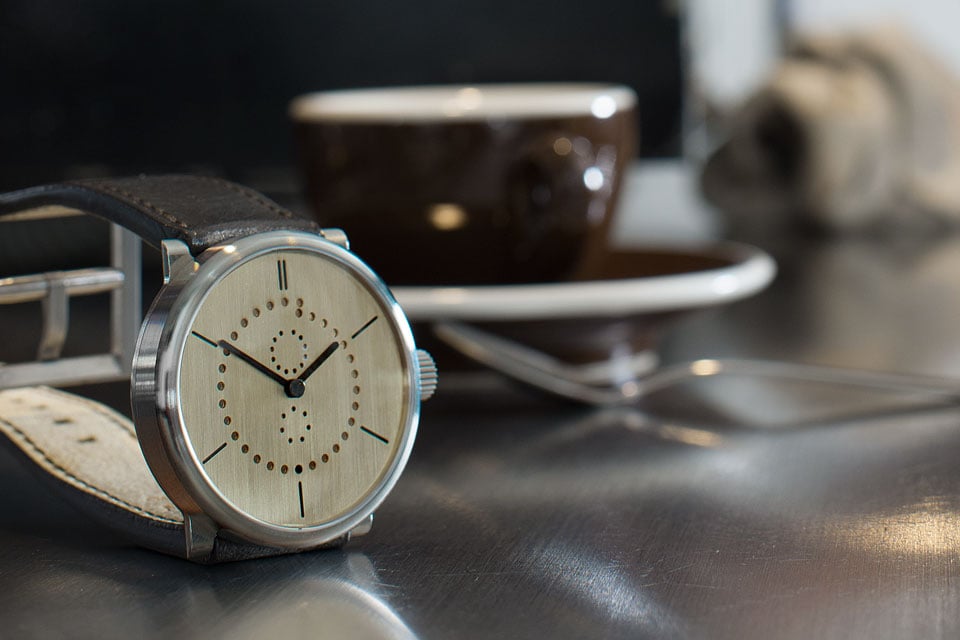Introducing the Ochs und Junior Annual Calendar Brass

Avid Monochrome readers know the minimalist watch brand from Beat Weinmann and Ludwig Oechslin by now. Ochs und Junior find it a challenge to create useful complications with as little as possible parts. That kind of minimalism also finds its way into the entire design of the watch, including the bare brass dial, the raw titanium two-part case and the annual calendar with just three (3) moving parts!
Yes three moving parts for the annual calendar and we’ll explain you how they did it. Keep in mind that the average annual calendar comprises up to 40 parts. In all honesty, this annual calendar comprises six parts, of which three are moving parts, so still brilliantly impressive! With such a construction, it is probably the most rigorous annual calendar on the planet and Ochs und Junior give you a life time warranty on it!

The three moving parts are on the right, in the middle is the dial (yes, it’s a part of the annual calendar mechanism and you’re looking at the back side of the dial) and on the left are two more fixed parts of the annual calendar. First of all, an annual calendar only has to be adjusted ONCE A YEAR. So only in the month of February you should adjust the calendar. All other months, including July/August with both 31 days, are ‘stored’ in the gears so to speak.
Most calendar mechanisms are using conventional watchmaking solution of levers and springs. Oechslin came up with a solution with some gears and some fixed parts. Not only do you get a more simple solution (less parts that can break or malfunction), rotating gears are also the least problematic parts in any mechanical movements. That means less wear and tear, less friction, less forces in the movement which can influence the watches chronometric rates. And with an ‘engine’ like the ETA 2824/2, which Ochs und Junior are still using, there’s not much that can go wrong.

Same goes for the case, dial, hands, strap and buckle. Minimalism is the word. The dial is, as you could see in the photo with the parts, multifunctional. Yes, it’s part of the annual calendar and yes, it is also a dial. Milled from a piece of brass, with a simple brushed finished on the front side. Over time that dial will get a beautiful patina. It will slowly age together with you.
The case – again minimalism is the word – is made of two parts. Most watch cases are typical three-part cases and have a mid case, a bezel and a case back. The mid case usually holds the movement and both case back and bezel are attached to the mid case. That’s different with Ochs und Junior (of course), because their case back is also a part of the mid case and holds the movement in place. The bezel is also a part of the mid case, as it closes the entire case and holds the crystal as well.

The fewer parts, the fewer can go wrong. The newest creation from Ochs ud Junior is available in two metals, titanium or silver, and both look great with the raw brass dial. No colors are added, just 100% brass. All dial elements, including the hands, are formed from brass.
And if you wonder how to read day, date and month on the annual calendar, it does require a few minutes of ‘adjusting’ your own intuition. Once you read it 2, 3 or 4 times, you fully understand it and reading these calendar indications is intuitive and is as fast as on any other annual calendar. Oechslin wanted to stay clear from the usual numbers, and from experience I can say this really works easy.
The circle with holes in the dial, indicates the date. There are 31 holes and number 1 is on the right side of the double stick marker at twelve o’clock. At every ten minutes is a stick marker and that A) helps with reading the time and B) helps with fast reading the date. In the photo below it is the 11th of the month.

There are two smaller circles of holes, the upper being the indicator for the months and the lower indicates the day of the week. The month advances counter-clockwise and the photo above indicates the month of February. The day of the week indication starts with the hole that is closest to the center of the dial, which is for the Sunday, and also advances counter-clockwise. In the photo above it’s Saturday. So reading the time, date, month and day of the week: It’s 10:12h on Saturday 11 February.
And if you take a really close look, than you can see a very small dent in the center cap of the hands, which is the seconds indicator. It’s close to 15 seconds past the minute.
Some specifications:
- 3 moving part annual calendar innovation by Ludwig Oechslin
- ETA 2824-2 base movement
- 39mm or 42mm
- Titanium case, crown and buckle (also available in silver)
- All dial components executed in hand-patinated or brushed brass (custom color options also available)
Price: 8,000 CHF in titanium – 10,000 CHF in silver (incl. 8% Swiss VAT)

More info and ordering through the Ochs und Junior website – click here!




3 responses
Did not Willy Messerschmitt (of WWII plane fame) also create a watch with three moving parts in 1948?
I searched for some info about that, Michael, but couldn’t find it. Maybe you have more info on the topic?
I was reading an article in Aviation History magazine about Wilhelm (Willy) Messerschmitt. In it it was stated that while waiting for the ’48 Nuremberg trials, he came with the drawings for a 3 moving part watch that he sold to a Swiss company giving him seed money for additional aircraft after the War.